Browse using the new Vinous website now. Launch →
Printed by, and for the sole use of . All rights reserved © 2015 Vinous Media
Pichon Longueville Comtesse de Lalande 1921-2016
BY ANTONIO GALLONI | OCTOBER 20, 2017
Pichon Longueville Comtesse de Lalande is arguably the single hottest château on Bordeaux’s Left Bank right now. Quality has been steadily on the rise for some time, culminating in a trio of spectacular wines in 2014, 2015 and 2016. This remarkable retrospective, many months in the making, provided a fascinating opportunity to explore the château’s rich history.
“Tell me your birth year,” Pichon Lalande’s Technical Director Nicolas Glumineau wrote when he confirmed our appointment “and don’t tell me it is 1961,” he added dryly, no doubt in reference to what must be a very small stock of remaining bottles from one of the most historic vintages in Bordeaux of the last century. Imagine my surprise when I walked into Pichon Lalande’s gleaming new tasting room and saw not only the 1961, but pretty much every vintage of note going back to the 1920s. And, in case you are wondering, no, 1961 is not my birth year.
I tasted all of the wines in this article with Glumineau and Charles Fournier, who serves as Pichon Lalande’s Head of Sales and Marketing. Glumineau organized the wines into two groupings. We started with younger wines from 2005 through 2016, tasted in ascending order, that provided a fascinating opportunity to track the evolution of Pichon Lalande, first under the Rouzaud family’s stewardship, and then in the years since Glumineau arrived from Montrose. The second flight started with the 1989 and moved back through series of older vintages culminating with the 1921. I can only describe tasting these vintages as one of the most totally hedonistic experiences of my life.
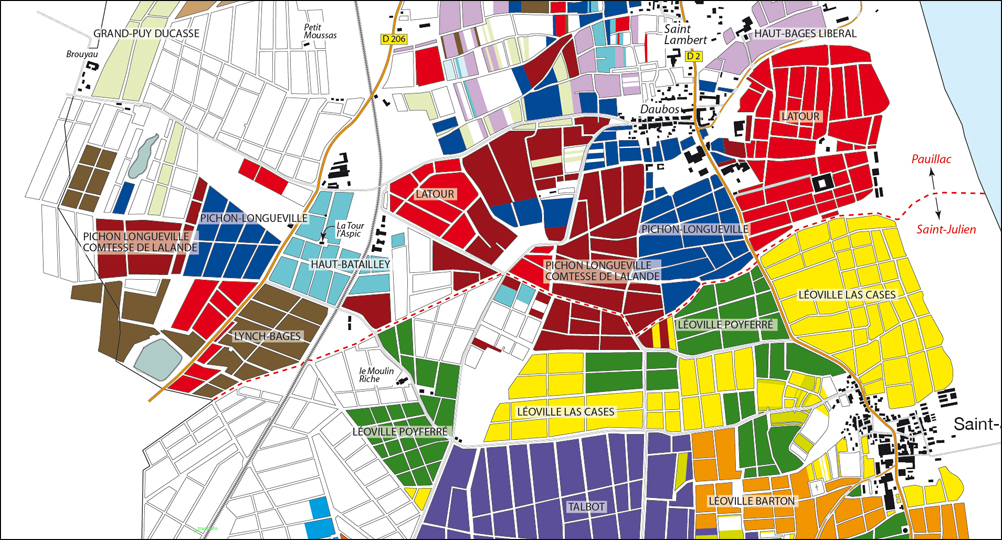
A view of Pichon Lalande and neighboring châteaux in Pauillac and Saint-Julien. © 2017, Alessandro Masnaghetti. Used by permission.
A Brief Overview
Pichon Longueville Comtesse de Lalande, often referred to informally as Pichon Lalande or Pichon Comtesse, is listed as a second growth in the Bordeaux classification of 1855. The estate lies on the border shared by Pauillac and Saint-Julien, which is represented by the red dotted line on the map above. Pichon Lalande’s ninety hectares of vineyards are cradled between those of Latour, Pichon Longueville (also known as Pichon Baron) and Haut-Batailley in Pauillac, and Léoville Poyferré and Léoville Las Cases in Saint-Julien. The nucleus of parcels is adjacent to Pichon Longueville, while the château, offices and tasting room are on the opposite side of the road, next to Latour. Readers will note that some of Pichon Lalande’s vineyards are actually in Saint-Julien. The château is granted an exemption for those parcels that allows them to be used for Pauillac wines.
Pichon Lalande’s Grand Vin is typically a blend of Cabernet Sauvignon, Merlot, Cabernet Franc and Petit Verdot. Among properties on the Left Bank, Pichon Lalande has often been known for an elevated presence of Merlot. In recent years, however, Pichon Lalande has moved to increase their plantings of Cabernet Sauvignon, with the belief that Cabernet is fundamentally better suited to the portion of the château’s soils that are on gravel. The map below illustrates Pichon Lalande’s varietal breakdown in the field.

Varietal composition of Pichon Lalande’s vineyards. © 2017 Alessandro Masnaghetti. Used by permission
Pichon Lalande’s Rich Historical Legacy
Historical records show that Bordeaux merchant Pierre Desmezures de Rauzan acquired land in Pauillac in the late 17th century. De Rauzan was a highly influential figure in his time, as he also managed Château Latour and Château Margaux. In 1694, de Rauzan’s daughter, Thérèse, married Baron Jacques Pichon de Longueville. Part of the dowry included a large property in Pauillac that became the Pichon estate. Baron Joseph de Longueville later inherited the property and managed it until he passed away in 1850, aged 90. The estate was then divided between Baron Joseph’s two children. Virginie, who in 1818 had married Charles Henri the Comte of Lalande, received the land that is today Pichon Longueville Comtesse de Lalande, while Raoul inherited the portion that is the present-day Pichon Longueville Baron. Brothers Edouard Miailhe and Louis Miailhe purchased Pichon Lalande in 1925. They would later go on to invest in a number of properties, including Château Palmer. Edouard Miailhe’s daughter, May Eliane de Lencquesaing, took over the management of the château in 1978 and became one of the great ambassadors in the world for Bordeaux and its wines during a brilliant career that spanned four decades.
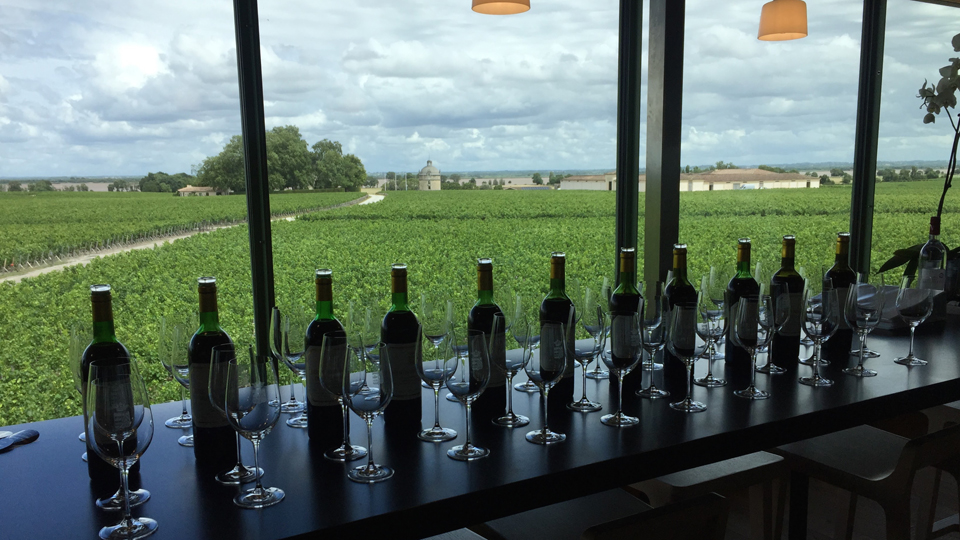
The Pichon Lalande tasting room provides stunning views of Château Latour
The Present Day
Frédéric Rouzaud, the patriarch of the Champagne Roederer group, purchased Pichon Lalande in 2007. A totally new cellar outfitted with modern equipment was in place for the 2013 harvest. Further investments continue throughout the property. One of the many things Rouzaud has succeeded in doing is building a company that, despite its size, still retains the feel of a family-run business rather than that of a conglomerate.
Technical Director Nicolas Glumineau arrived from Montrose in 2012. Over the years, I have observed that many of the world’s greatest wines are made by people whose life experiences include time spent in other fields. Originally trained as a lyric baritone, Glumineau made a switch to engineering in 2004 out of a desire to have more stable family life, something that is virtually impossible for a professional touring musician. Stints at Haut-Brion in 2005 and Margaux in 2006 followed, before Glumineau landed at Montrose, where he worked from 2007 through 2012. Glumineau’s first vintage at Pichon Lalande from start to finish was 2013. Talk about trial by fire.
Among recent developments at Pichon Lalande has been a much more flexible approach to picking. Up until around 2010, the harvest took place within a fairly compressed span of 10 to 14 days. Today, the harvest might still involve 10 to 14 days of picking, but that time is now spread out over 4 to 5 weeks. Of course, this very flexible approach to harvesting and seeking optimal ripeness parcel by parcel is only made possible because of the arrival of smaller fermentation tanks, one of the single biggest changes in the way Bordeaux wines are made today as opposed to a generation ago.

Technical Director Nicolas Glumineau in Pichon Lalande’s new cellar
The Wines, Part One: 2005-2016
The 2005 Pichon Lalande is not an inspiring wine, particularly within the context of the year and also the vintages that follow in this tasting. Despite its pretty, expressive bouquet, the 2005 is dark, powerful and excessively heavy, with drying tannin that suggests either overextraction or the effects of a growing season marked by severe drought. Time in the glass does seem to help the release of some freshness in the cherry, floral and mint flavors, but the coarse tannins are ultimately impossible to get past. I imagine the 2005 will last for several decades given its concentration, but I don’t expect it to ever be a wine of finesse or nuance. During this era, Pichon Lalande was a wine made by committee. Perhaps for that reason, it does not seem to have an especially well-defined personality. Hubert de Boüard, Eric Boissenot and Denis Dubourdieu all had a hand in the 2005. I am reminded of the classic expression “too many cooks in the kitchen….” One of the most pleasant and unexpected surprises in this tasting, the 2006 Pichon Lalande is gorgeous, which is something I can’t say about too many wines in a vintage marked by climatic ups and downs and irregular ripening. Dark, powerful and intense, the 2006 possesses exceptional balance. A host of black cherry, plum, smoke, licorice and menthol flesh out in this decidedly somber, virile Pichon Lalande. In a vintage in which so many wines are so rustic, the 2006 Pichon Lalande is all class. This sleeper Pichon Lalande will drink well for at least the next two decades, perhaps longer.
Another surprise in this part of the tasting, the 2007 Pichon Lalande is an excellent choice for drinking now, as the aromatics have started to open up nicely. Hints of sweet tobacco, sage and herb all lift from the glass. There is more than enough depth to support another 15-20 years of fine drinking. The 2007 is not a big wine, but instead makes a compelling case for itself with striking aromatic intensity, silky tannins and that most elusive quality of all: balance. This is very nicely done, especially within the context of a year marked by a cool and wet summer. Super-ripe black cherry, plum, smoke, licorice make a strong opening statement in the 2008 Pichon Lalande. The late harvest that year yielded a decidedly super-ripe, exotic Pichon Lalande with captivating inner sweetness and gorgeous textural finesse. Naturally, the 2008 is young. Very young. Even so, it is stunning. Readers looking for an under-the-radar vintage to cellar of Pichon Lalande will find tremendous satisfaction and pure pleasure in the 2008. An Indian summer saved what had up until that time been a rainy and not especially promising vintage.
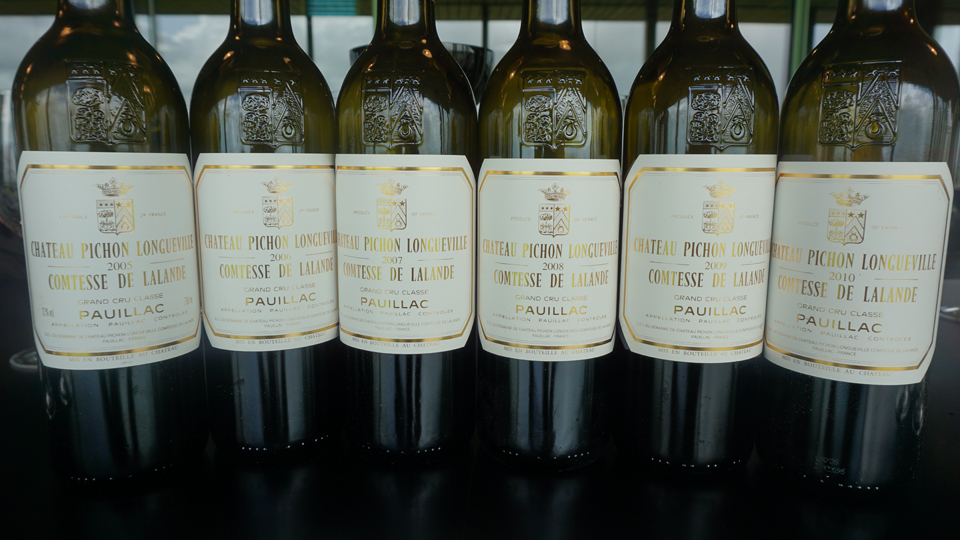
The 2008 and the 2010 are among the stars in this grouping of more recent vintages
The 2009 Pichon Lalande is ripe and decidedly flamboyant from the very first taste. Dense and voluptuous in the glass, with serious richness, the 2009 is also almost shockingly tannic. It won’t be ready to drink anytime soon, and yet, there is so much to look forward to. The warm, dry conditions yielded a dense, exotic Pichon Lalande, but there is serious structure beneath all of the fruit. An eternal wine, the 2010 Pichon Lalande is a total showstopper. The first impression is one of explosive power, but time in the glass brings out the wine’s more delicate, floral side. Violet, graphite, crème de cassis, licorice and menthol overtones recall the 1996, but the tannins here are much softer, sweeter and more polished. In two recent tastings, the 2010 has been positively stellar. The alternation of hot days and cool nights led to a late harvest. The Cabernet Sauvignon harvest did not start until October 7; by that date in 2009 all the fruit was in. Readers who can still find the 2010 should not hesitate, as it is a modern-day classic. That’s all there is to it.
My impression is that the 2011 Pichon Lalande will have its day, one day. For now, big, burly tannins give the 2011 a decidedly monolithic feel. To be sure, there is plenty of fruit density and power lurking in the glass, but the 2011 needs more time in bottle before it starts showing at its best. Two thousand-eleven was marked by an unusual weather pattern in which spring was quite warm and dry, but then summer was cool. As it always is, the 2012 Pichon Lalande is a wine of pure and total seduction. The 2012 is neither the biggest nor most complex Pichon Lalande, but it is among the most pleasurable wine in this tasting, especially for near and medium-term drinking. Silky and medium in body, with lovely brightness, the 2012 has so much to offer.
The 2013 Pichon Lalande is one of the better wines of this very challenging vintage. There is lovely depth and intensity in the glass, within the context of the year. Scents of sweet tobacco, anise and dried cherry open up nicely. Slightly green, vegetal notes are impossible to look past in this small-scaled Pichon Lalande. Late-ripening varieties were favored in a year in which rot posed significant challenges in the field. Quite unusually, in 2013 Pichon Lalande is 100% Cabernet Sauvignon. This is the first vintage Nicolas Glumineau made at Pichon Lalande from start to finish. One of the highlights in a dark horse vintage for Bordeaux, the 2014 Pichon Lalande is absolutely exquisite. Aromatic and silky on the palate, with bright, finely sculpted fruit and mid-weight structure, the 2014 is a picture-perfect example of the best 2014 has to offer. I have always adored the 2014 Pichon Lalande. This tasting only serves to reinforce that feeling. Ideal conditions in September extended the harvest and yielded perfumed, silky wines.
A wild, exotic wine, the 2015 Pichon Lalande is a freak of nature. Even at this early stage in its life, the 2015 is racy and plush to the core, with no hard edges and a level of flamboyance that is out of character for Pichon. No matter, the 2015 is fabulous. Super-ripe, dark and exotic, the 2015 will surely need a bit of time to shed some baby fat, but is utterly magnificent. Wow! The 2016 Pichon Lalande is one of the must-have wines of the year. I felt that way every time I saw it during the spring en primeur tastings. A few more months in bottle has only made that potential even more obvious. At once powerful and yet also delicate, the 2016 is a regal, aristocratic wine endowed with class and pedigree to burn. The crème de cassis, violet, graphite and menthol flavors are finely sketched, sure, but what stands out most is the wine’s extraordinary balance. While the 2015 is a soloist, the 2016 is an orchestra.
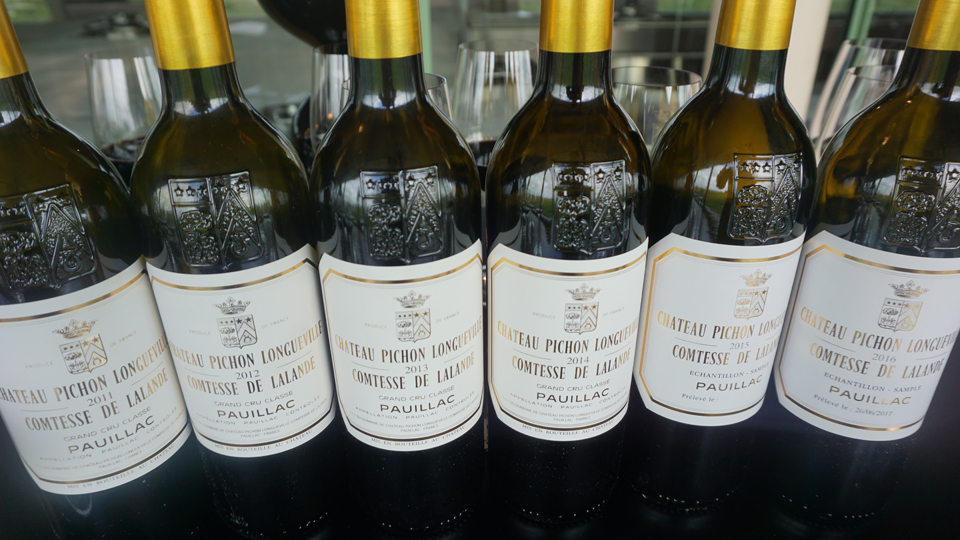
The 2016 is every bit as phenomenal as it has always been, while the 2014 remains an under the radar gem
The Wines, Part Two: 1989-1921
The second part of this tasting kicks off with the 1989 Pichon Lalande. Off the charts aromatic intensity, silky tannins and exceptional finesse give the 1989 much of its considerable allure. Crushed flowers, sweet red fruit, tobacco, cedar and incense are some of the many notes that waft from the glass, but it is the wine’s textural finesse that elevates it into the realm of the profound. Wonderfully alive and delineated in every way, the 1989 is one of many highlights on this magical afternoon. Another dazzling wine, the 1982 Pichon Lalande is utterly profound from the very first taste. In the glass, the 1982 is powerful and explosive, with seemingly endless layers of flavor that continue to unfurl over time. Vivid, intensely aromatic and seamless, the 1982 has enough pedigree and depth to drink well for at least several decades. What a wine!
A host of Cabernet Sauvignon-infused aromas make a strong opening statement in the 1978 Pichon Lalande. There is certainly no shortage of power or character. If anything, the 1978 is perhaps a bit lacking in mid-palate depth, which gives it an element of austerity. Aside from that small critique, the 1978 is deeply expressive and gorgeous. The 1970 Pichon Lalande is bold, powerful and rustic in style. Iron, smoke, tobacco, game, licorice and dried stone fruit character are pushed forward. The aromatics are more focused and pleasing than the palate, where the 1970 is marred by traces of brett. All things considered, the 1970 has held up well, but any remaining bottles need to be finished.
The 1966 Pichon Lalande possesses remarkable depth and pure power. A slight element of cork suggests this bottle might not be perfect, but the textural depth and intensity for a 51 year-old wine are truly remarkable. This bottled was re-corked at the chateau in 1986. One of the most captivating wines in this tasting, the 1961 Pichon Lalande is magnificent. A wine with off the charts intensity, the 1961 proves to be utterly captivating. Specifically, the 1961 manages to be both powerful, yet translucent. Silky tannins, floral overtones and exquisitely layered flavors give the wine its striking purity and finesse. The 1961 is a highlight on an afternoon full of unforgettable wines. Deep and powerful on the palate, the 1959 Pichon Lalande has held up beautifully. There is a level of textural resonance to the 1959 that is incredibly appealing. This bottle, re-corked at the château in 1981, appears to be less than perfect. Even so, the wine’s depth and integrity are both remarkable.

This set of older vintages of Pichon Lalande is full of highlights
What a total pleasure it is to taste the 1953 Pichon Lalande. A wine of exquisite aromatic nuance and finesse, the 1953 dazzles today. Hints of sweet tobacco, licorice and incense add inner perfume in a mid-weight, polished Pichon Lalande that speaks to refinement above all else. For its total harmony and poise, the 1953 is one of the most memorable wines of the afternoon. Well-stored bottles will drink well for another decade or more. Today, it is a wine of pure and total pleasure. In 1953, Sir Edmund Hillary and Tenzing Norgay became the first two people to summit Mount Everest, the first polio vaccine was developed, and the Korean War ended. The 1953 Pichon Lalande remains a timeless beauty. It’s impossible to taste the 1945 Pichon Lalande and not think about the state of France and the world when it was made. Shockingly rich and intense on the palate, the 1945 remains incredibly flamboyant. I suppose there is a slight element of volatile acidity that accompanies the elevated alcohol and extreme ripeness, but in the end, those very human imperfections can’t take away from the spine-tingling emotion that the 1945 delivers. After six years of brutal fighting and heavy casualties, World War II came to a conclusion in September 1945.
A wine of haunting, beguiling beauty, the 1929 Pichon Lalande is all sensuality. Tea leaves, dried rose petal and a distinct touch of apricot are some of the notes that give the 1929 its exotic personality. Of course, the 1929 is fully mature, perhaps even past peak. Even so, it is positively alluring. It is fascinating to taste the 1929 and contemplate events that were taking place while the wine was being made. In the United States, the Wall Street Crash triggered the Great Depression, which then spread to Europe, where it had devastating consequences. The 1921 Pichon Lalande is almost shockingly powerful, dense and deep for a wine of its age. At nearly 100 years of age, it is obvious the 1921 has aged beautifully. This is not my favorite stage to enjoy or drink wine, but the 1921’s tenacity is certainly admirable. The color is not perfect – not that I expect it to be at this stage – and yet there can be no doubt the 1921 is a tremendous wine that peaked some time ago. That said, I am thrilled to have an opportunity to taste it.
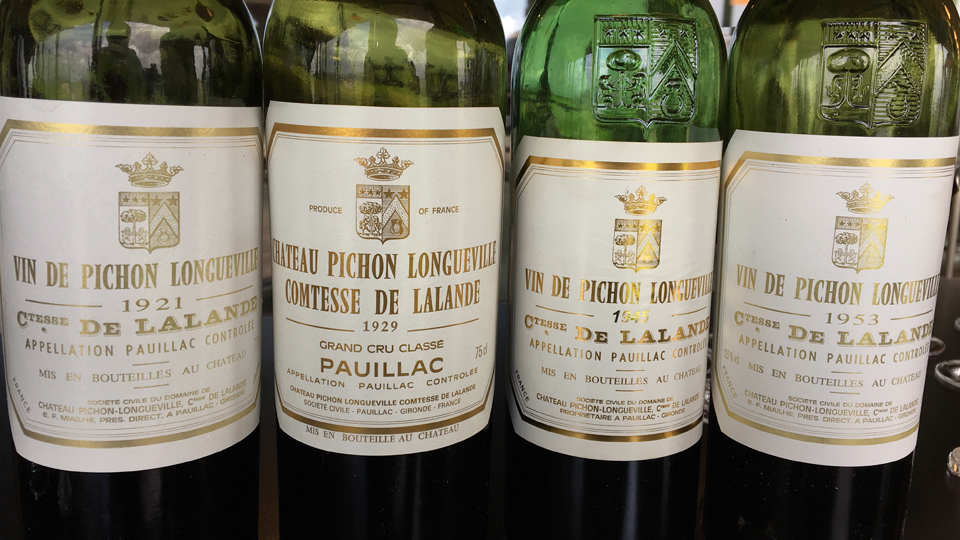
Tasting this quartet of vintages back to 1921 is a deeply emotional experience
There are no more wines to taste, at least not today. And yet I am left thinking about some of the vintages that made the deepest impression. Was it the 1982, with its extraordinary balance? Or maybe the epic 1961, a wine that is still so young? What about the war-era 1945? Among the young wines, the 2008, 2009, 2010, 2015 and 2016 all appear to have the potential to one day join the truly epic vintages of the twentieth century as some of the most profound wines made at Pichon Lalande. It’s hard to say. I can only hope to have a chance to repeat this vertical some years from now, and to be able to write about it.
I tasted all of the wines in this article during a visit to Pichon Lalande in June 2017. I am deeply indebted to my esteemed colleague Alessandro Masnaghetti for sharing excerpts from his map of the vineyards of Pauillac, Saint-Julien and Saint-Estèphe.

The Pichon Lalande barrel room
See All the Wines in the Order Tasted
You Might Also Enjoy
2016 Bordeaux: It’s Now or Never, Baby, Antonio Galloni, April 2017
2016 Bordeaux: 30 Top Values, Antonio Galloni, April 2017
Larcis Ducasse Retrospective: 1945-2014, Antonio Galloni, March 2017
Mouton Rothschild: 2003-2015, Antonio Galloni, May 2016
2014 Bordeaux – Les Découvertes: Under the Radar Gems and Sleepers, Antonio Galloni, May 2015
